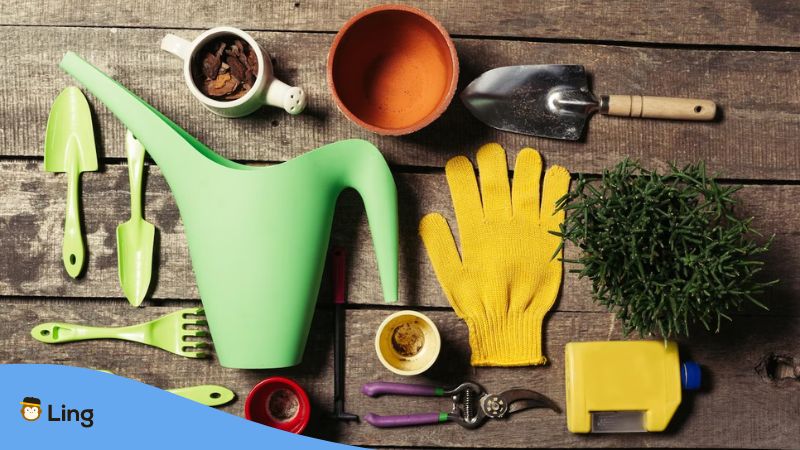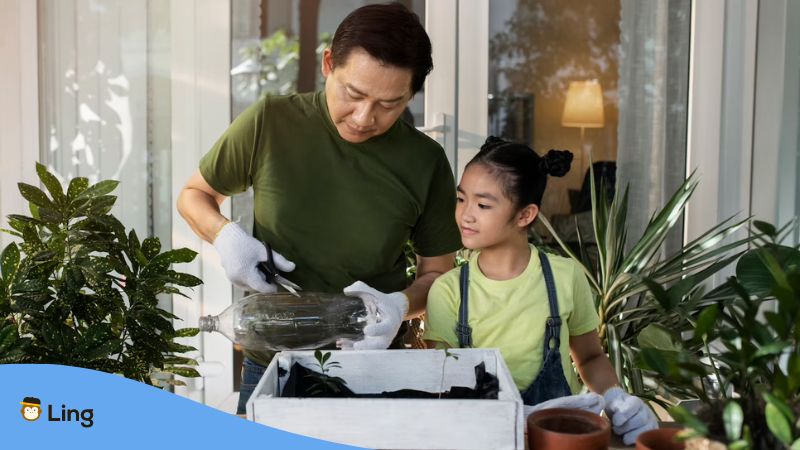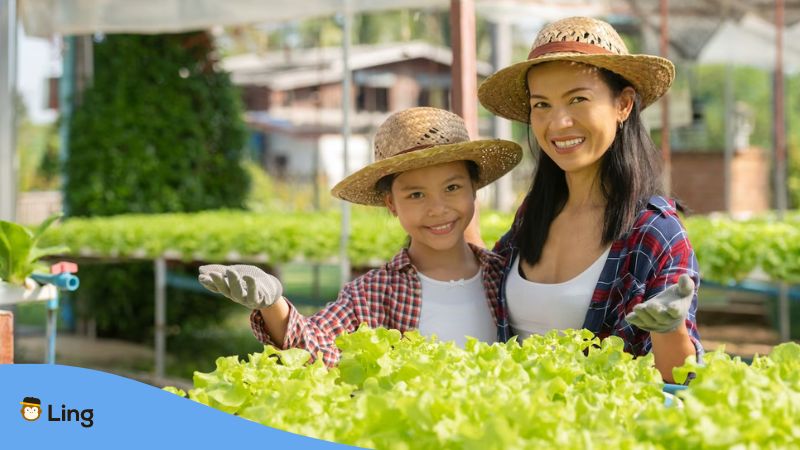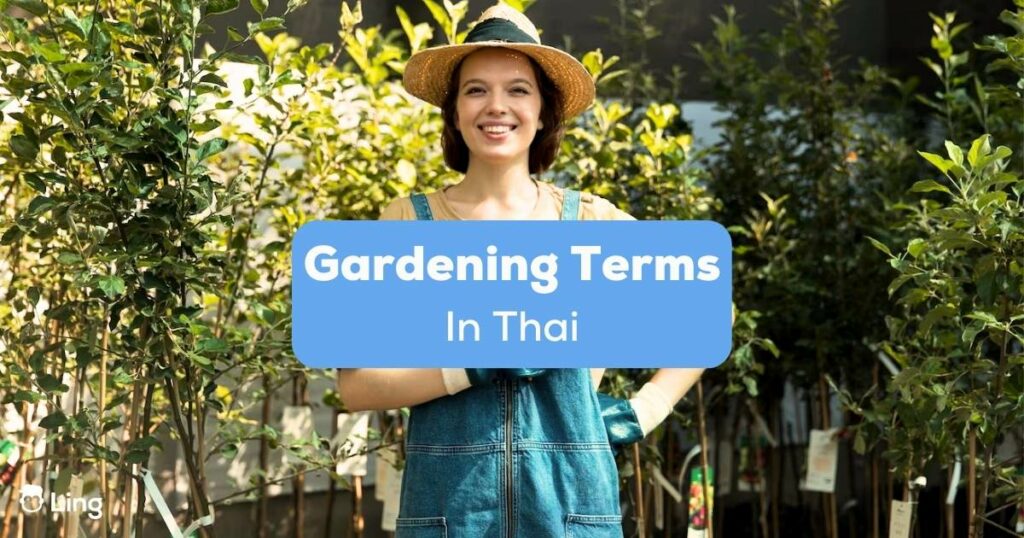Who says gardens speak only the lingo of nature? In fact, they speak many tongues, the Thai language included! You might have tasted it in their cuisine. But how about hearing it in their gardens? Here’s the deal. We’re going on a trip; not just any trip, but a unique Thai gardening adventure!
We’ll learn gardening terms in Thai, their uses, and even cultural tidbits. We’ll meet “Suan” (สวน), the Thai word for garden, and “Horapa” (โหระพา), the spicy basil! All this while having a bit of fun. Sounds good, right? Let’s go!
Thai And Gardening: Why This Combo Works
Ever wondered why a map is important to a traveler? The answer is simple: it provides guidance. Similarly, understanding Thai is your guide when gardening in Thailand. But why Thai, you might ask.
Well, because language and culture are inseparable, my friends! To grasp the essence of Thai gardening, you need to dig into its language roots. And don’t you think knowing the local language is handy when buying seeds or plants or asking a fellow gardener for tips?
According to the locals, the Thai people cherish gardening for its ability to “Connect with Nature” “เชื่อมต่อกับธรรมชาติ” (chueam dtà-gàp tham-ma-chát), preserve cultural traditions, offer therapeutic benefits, and provide a canvas for creativity and aesthetics.
Speaking The Language Of Nature
Imagine you’re in a Thai garden. You see a plant that captures your attention.
What’s its name? How does it grow?
This is where your Thai language skills come into play.
You can ask a fellow gardener, “Ton nii kuea arai na khráp?” (ต้นนี้เคยอะไรนะครับ?) which means “What is this tree called?”
When they reply, “Manila tamarind,” you recognize it in Thai as “Makham thet” (มะขามเทศ).
You’ve not only learned a new plant name but also how to ask about plant species in Thai.
Mastering The Craft With Thai
How about gardening techniques? Thai gardens are famed for their tropical appeal, aren’t they?
They are lush, verdant, and teeming with exotic plants.
But how do they do it?
The answer lies in the Thai language.
Knowing terms like “Tad taeng king mai” (ตัดแต่งกิ่งไม้), which means to prune, or that “Thon yaa” (ถอนหญ้า) signifies weeding, empowers you to learn Thai gardening methods.
Thai Basic Words Related To Gardening
Before we dive deep into the gardening activities terms in Thai, let’s first expand your vocabulary with some of the common words related to plants. Who knows? You might just be able to use some of these during your plant-related convo!
Soil – “ดิน” (Din)
At the core of every thriving Thai garden lies the soil—the unsung hero of plant growth).In Thai gardening, the secret to flourishing plants is rich, well-drained soil. It’s the nurturing foundation that brings nature’s beauty to life.
Plants – “พืช” (Phuech)
In Thailand, there’s a profound love for plants. The Thai language is rich in words to describe nature, with terms like “ดอกไม้” (dok mai) for flowers and “ต้นไม้” (ton mai) for trees. Each word is a brushstroke painting, the vibrant canvas of their botanical affection. Thais are fervent wood crafters with access to a huge array of indigenous woods.
Planting – “ปลูก” (Pluk)
Planting seeds or young plants is a fundamental gardening practice known as “ปลูก” (pluk). This step is pivotal for gardeners as it marks the beginning of the plant’s journey and plays a crucial role in its growth and development. Proper “ปลูก” ensures a strong foundation for a thriving garden.
Watering – “รดน้ำ” (Rod nam)
Keeping your “สวน” garden (suan) well-hydrated is essential, and to do it effectively, you need to understand the art of watering, known as “รดน้ำ” (rod nam) in Thai. Proper watering techniques are vital to ensure your plants receive the right amount of moisture, promoting their health and growth. Mastering “รดน้ำ” is a key skill for any gardener.

Planting The Seed: Common Gardening Terms In Thai
Got your gardening gloves on? Great! Now, let’s get our hands dirty with some gardening terms in Thai.
From tools to techniques, we’ve got it all covered.
Trust me, by the end of this section, you’ll be able to chat with a Thai gardener in their language.
Tools Of The Trade
Thai gardens are works of art. And just like any artist, gardeners need their tools.
Here are the common ones with their Thai names:
- “Job” (จอบ): This is your trusty hoe. It’s handy for preparing the ground for planting. It breaks up hard soil and makes it easier for roots to penetrate. It’s also great for weeding!
- “Phueak” (พวก): Meet your new friend, the spade. This tool is a garden’s bread and butter. Need to dig a hole for a new plant or move some soil around? “Phueak” is your go-to tool.
- “Khrueang chai tua din” (เครื่องใช้ตักดิน): Or simply, a rake. It’s used for a variety of tasks. Clearing fallen leaves, spreading soil or compost, or leveling the ground, this tool is a multitasker.
- “Loht tua” (ล้อตัว): This is the Thai name for a wheelbarrow. Think of it as your garden vehicle. It’s used for transporting plants, soil, compost, or other gardening tools. A real workhorse in the garden!
- “Thung meu suan” (ถุงมือสวน): These are your gardening gloves. They protect your hands from thorns, blisters, and dirt while gardening. Plus, they provide a better grip on your tools!
- “Kan raik tat king” (กรรไกรตัดกิ่ง): These are your pruners. Perfect for cutting back overgrown plants or pruning to encourage better growth. A must-have for any Thai garden!
- “Tho nam” (โถน้ำ): Watering can. Essential for watering plants, especially those delicate ones that might not enjoy a full blast from the hose.
- “Som fork” (ส้อมฟอร์ก): The garden fork. This tool is excellent for turning soil, especially heavy clay. It’s also perfect for breaking up large clumps of soil.
- “Krathang pluk ton mai” (กระถางปลูกต้นไม้): Planting pot. These are indispensable in a Thai garden, whether for starting seeds or growing small plants.
- “Kriang” (เกรียง ): The trowel. This tool is ideal for smaller tasks like transplanting seedlings or digging out stubborn weeds. A versatile tool for any Thai gardener!
Gardening Techniques
Next stop, techniques! Just as plants have their growth cycles, gardens have their techniques.
Here are a few you might encounter in Thai gardening:
- “Sàet” (แซ่ต) Pruning: This technique keeps plants healthy and shaped to your liking. It involves cutting away dead or overgrown branches or stems.
- “Khàt” (ขัด) Weeding: A critical part of gardening, this technique involves removing unwanted plants that compete with your desired plants for nutrients and sunlight.
- “Plook” (ปลูก) Planting: This is the heart of gardening – putting a plant in the soil. But it’s not just about digging a hole; you must ensure the correct depth and spacing.
- “Lin náam” (รินน้ำ) Watering: It sounds simple, but different plants need different amounts of water. It’s about knowing when and how much to water.
- “Rái sànaal” (ไถสนาม) Tilling: This technique breaks up the soil to prepare a new garden bed, making it easier for plants to take root.
- “Wíai náam” (วายน้ำ) Irrigation: This refers to the method of providing water to plants, which can be through sprinklers, drips, or hoses.
- “Khàt dòk mài” (เก็บดอกไม้) Deadheading: This is the process of removing faded or dead flowers to encourage the plant to focus its energy on new growth.
- “Gèp gìao” (เก็บเกี่ยว) Harvesting: This vital step involves gathering or collecting mature crops or fruits from your plants. It ensures you reap the rewards of your gardening efforts and enjoy the fresh produce.

Cultivating Knowledge: Understanding Thai Gardening Practices
Just planted your first Thai basil? Fantastic! Now, let’s delve a bit deeper into Thai gardening.
Thai gardening isn’t just about tending to plants.
It’s understanding the climate, applying unique techniques, and appreciating local flora.
Climate Considerations
When you think about Thai gardening, understanding the local climate is crucial.
Consider “Phrik” (พริก) or chili peppers.
They thrive in the warm and humid Thailand weather.
They require lots of sunshine and good drainage, typical in tropical climates.
And it’s not just “Phrik.” Even “Horapa” (Thai basil) loves their sun-soaked gardens.
So, when you’re in Thailand, think tropical. It’s what their plants love!
Thai Gardening Techniques
The art of Thai gardening includes some unique techniques.
Take, for example, their approach to composting.
They use vegetable scraps, like leftover “Krathin” (Leucaena) pods or “Krachai” (Thai galingale) cuttings, turning waste into nutrient-rich compost.
It’s this make-do philosophy and respect for nature that underpin Thai gardening.
The Significance Of Local Flora
Gardening in Thailand isn’t just about growing food. It’s about cultivating an appreciation for their natural heritage.
Local flora, like the “Krathin” tree, are more than just plants.
They’re symbols of their commitment to a sustainable lifestyle.
In Thai gardens, “Krathin” trees not only provide shade but also enrich the soil as a nitrogen-fixer.
Similarly, growing “Krachai” at home means you have a fresh supply of classic Thai spices.
You see, every plant in a Thai garden plays a part in the bigger picture.
It’s about living harmoniously with nature!

From Garden To Kitchen: The Role Of Thai Gardens In Thai Cuisine
The Thai garden is a treasure trove of flavors. These aren’t just plants. They’re the soul of Thai cuisine.
Fresh herbs, zesty spices, crunchy vegetables; each one a star in Thai dishes.
But how exactly does the garden fit into their kitchens? Let’s find out!
Thai Cuisine: An Overview
Thai cuisine is all about balance.
Each dish is a delicate dance of these flavors: sweet, sour, salty, spicy, and bitter.
And where do these flavors come from? You guessed it, their gardens!
Think about it.
Fresh “Phrik” (พริก) chilies add a fiery kick, vibrant “Kaphrao” (กะเพรา) leaves lend a peppery touch, and tangy “Manao” (มะนาว) lime cuts through the richness.
The fresher the ingredients, the more flavorful the dish. That’s Thai cooking for you!
The Herb Garden
Step into a Thai herb garden, and you’re stepping into a world of flavors.
Take “Bai horapa wan” (ใบโหระพาหวาน), or Thai sweet basil.
Its sweet, anise-like flavor makes it a staple in dishes like “Pad Krapow Gai” (ผัดกะเพราไก่) or chicken stir-fried with holy basil.
Then there’s “Krathiam” (กระเทียม), or garlic, with its distinct and pungent flavor that adds depth to curries and various dishes.
And let’s not forget “Pak Chi” (ผักชี), or cilantro, a must-have garnish for soups like “Tom Yum Goong” (ต้มยำกุ้ง) or the spicy Shrimp Soup.
Each herb plays its part in creating unforgettable flavors!
Vegetables In The Thai Garden
Vegetables from Thai gardens aren’t just sides – they’re often the stars!
For instance, “Ma-khuea bprao” (มะเขือเปราะ), or Thai eggplant, adds a crunch to “Kaeng Khiao Wan” (แกงเขียวหวาน) or green curry.
Also, “Bai bua bok” (ใบบัวบก), or pennywort, is loved for its health benefits and is often made into a refreshing drink.
And did you know “Dok see thong” (ดอกสีทอง), or Hummingbird Tree flowers, are commonly used in salads and stir-fries for their unique, slightly bitter flavor?
In Thai cuisine, every vegetable has a role in creating a symphony of tastes!
Learn Gardening Terms In Thai With Ling!
What a journey we’ve been on! We’ve discussed the gardening terms in Thai, uncovering the vibrant blooms of vocabulary along the way.
We’ve explored how Thai gardens nourish their cuisine, adding depth and flavor to every dish.
But this is only the beginning of your language-learning journey.
Remember, you don’t have to do it alone.
The Ling app is your trusty language companion!
Get started on your path to fluency in Thai or delve into one of the 60+ other languages we cater to.
Our interactive lessons and practical exercises make language learning a breeze.
It’s like having your own personal language garden right in your purse!
So, let’s cultivate your language-learning adventure together.
Download the Ling app from Google Play and App Store and let your linguistic garden bloom!




































































